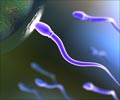Fertility problems: Boys born underweight are more likely to suffer infertility in adulthood, reveals a new study.

‘Fertility problems: Watch out, boys born underweight are more likely to suffer infertility in adulthood.’
Read More..




Researchers in Denmark looked at 5594 men and 5342 women born between 1984 and 1987 and followed them through to adulthood until the end of 2017. They found that men who had been born small for gestational age had a 55% increased risk of infertility as adults compared to men born within the appropriate weight range for gestational age. They found no link between gestational age and infertility in women.Read More..
Ms Anne Thorsted, who carried out the study when she was part of a research group from the Department of Public Health at Aarhus University, Denmark, said: "Among the men who were born small for gestational age, we found that 8.3% had been diagnosed or were being treated for infertility by the end of 2017 compared to 5.7% of men born with the appropriate weight."
Small for gestational age is defined as babies having birth weights in the bottom 10% according to each week of gestation compared to other children of the same gestational age. For instance, the weight range for babies born at full term (40 weeks) was between approximately 2500-4500 grams (5.5-9.9 Ibs) in this study, so full-term babies born weighing less than 3000 grams were defined as being small for gestational age and weighed less than 90% of other children of the same gestational age.
Previous research has suggested a link between restricted growth of the fetus in the womb and a two to three times increased risk of penis and testicular problems in boys; in particular, hypospadias (a malformation where the opening of the urethra is not at the tip of the penis), cryptorchidism (undescended testis) and testicular cancer. These conditions are linked to fertility problems. However, there have been few and conflicting studies on the link between birth weight for gestational age and infertility.
In the current study, when the researchers excluded men born with hypospadias or cryptorchidism, the link between being born small for gestational age and infertility weakened. They found a statistically non-significant 37% increased risk of infertility among the remaining men, with 7.3% of men born small for gestational age being infertile compared to 5.6% of men born with the appropriate weight.
Advertisement
She said it was not yet clear what the potential mechanisms could be for the link between birth weight and infertility.
Advertisement
"Our results show that sometimes we must look at the very early life to find explanations of health problems that occur later in life," she concluded.
The men and women in the study were all singleton births, born in two Danish regions, Aalborg and Odense, between 1984 and 1987. The researchers obtained information on birth weight and gestational age from birth records, and retrieved information on infertility diagnoses and fertility treatments from the Danish National Patient Registry and the Danish In Vitro Fertilisation registry.
The mothers of all the participants had completed a questionnaire during pregnancy that asked about factors that could affect the results, such as age, lifestyle (smoking and alcohol consumption), health (including body mass index) and sociodemographic status (employment and whether or not the parents lived together). At the end of the follow-up period in 2017, the average age of the participants was 32.
Strengths of the study include the large numbers and the high participation rate (87%) among the pregnant women involved in the "Health Habits for Two" study. In addition, the availability of data from the Danish registers resulted in a 98% follow-up rate for the participants, reducing the risk of bias and making it a representative sample.
The researchers acknowledge that the participants had not reached the end of their reproductive life by 2017 and it would be interesting to see what the situation was in another ten years' time.
Limitations of the study include that different methods were used for estimating gestational age, and that participants were classified as infertile if they either had a diagnosis of infertility or were part of a couple seeking fertility treatment, thus including lesbian and single mothers. However, when the researchers excluded all participants with missing information on the cause of infertility, the risk of infertility among men born small for gestational age increased from 55% to 88%, suggesting this might reflect the true risk of infertility in this group more accurately.
About 12.5% of couples are affected by infertility, which is defined as unsuccessfully attempting to conceive for a year or longer. Male infertility is responsible for about a third of cases, female infertility is responsible for another third and the remaining third is due either to problems in both the man and the woman or to an unidentified cause.
Source-Eurekalert















